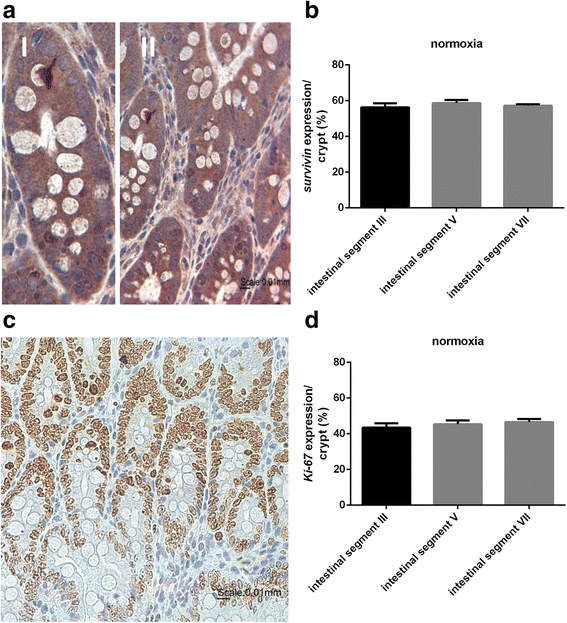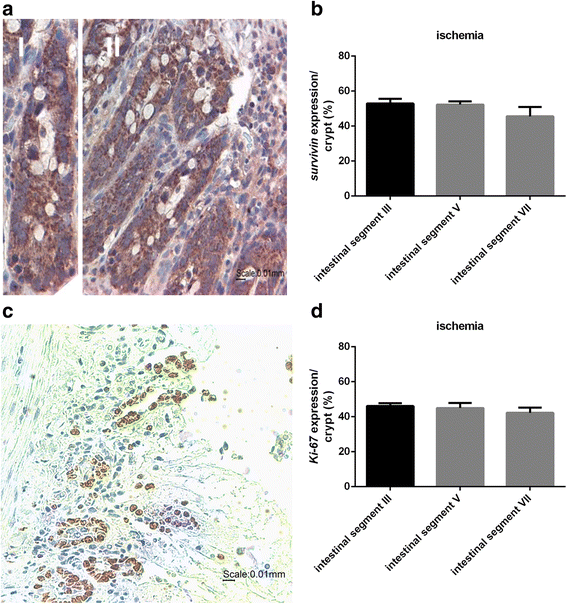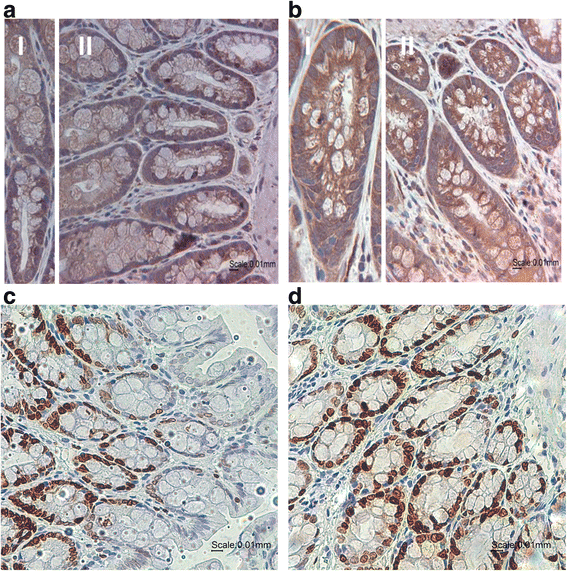Survivin expression pattern in the intestine of normoxic and ischemic rats
- PMID: 28615071
- PMCID: PMC5471735
- DOI: 10.1186/s12876-017-0625-6
Survivin expression pattern in the intestine of normoxic and ischemic rats
Abstract
Background: Survivin, a member of the inhibitor of apoptosis protein (IAP) family, regulates mitosis and chromosome segregation. The expression of survivin proceeds during embryonic development and in addition has already been demonstrated in cancer cells. However, there is also evidence of survivin expression in differentiated tissues, including the gastro-intestinal tract of adult rats. A study with human colon specimens exhibited survivin in most basal crypt epithelial cells of normal mucosa. There is rather limited information on survivin expression in the small intestine. In order to paint a more detailed and thus complete picture of survivin expression patterns in the gastrointestinal tract, we used an immunohistochemical approach in normal adult rat small intestinal and ascending colonic tissue. Moreover, to get deeper insights in the regulation of survivin expression after tissue damage, we also studied its expression in mesenteric ischemia-reperfusion (I/R) injury.
Methods: Mesenteric ischemia-reperfusion injury was induced in male Wistar rats (six animals/group) by occlusion of the superior mesenteric artery for 90 min and subsequent reperfusion for 120 min. Paraffin sections of untreated or ischemically treated tissue were assessed immunohistochemically by survivin and Ki-67 staining.
Results: Survivin could be detected in the small intestine and ascending colon of the normoxia group. It was expressed mainly in the epithelial cells of the crypts and only marginally in the villi. The individual small intestinal segments studied revealed comparable staining intensities. Likewise, expression of survivin was detected in the ischemically damaged small intestine and ascending colon. The expression pattern corresponded to the normoxic animals, as far as verifiable due to the existing tissue damage. Comparison of the expression pattern of Ki-67, a protein that acts as a cellular marker for proliferation, and survivin demonstrated a coincidental localization of the two proteins in the small intestinal and ascending colonic tissue.
Conclusions: Survivin was expressed strongly in epithelial cells of small intestinal as well as ascending colonic tissue. Its expression was located in cells with a high proliferation rate and regenerative capacity. This further supports the decisive role of survivin in cell division. Surprisingly, the ischemically damaged small intestinal and ascending colonic tissue showed a comparably high expression level. These results suggest that there is already a maximal survivin expression under normal conditions. However, the intestine is able to maintain the regenerative capacity even in spite of an ischemic injury. These findings reflect the important relevance of an intact intestinal barrier.
Keywords: Immunohistochemistry; Injury; Intestine; Ischemia; Rat; Reperfusion; Survivin expression.
Figures



Similar articles
-
MiR-146a protects small intestine against ischemia/reperfusion injury by down-regulating TLR4/TRAF6/NF-κB pathway.J Cell Physiol. 2018 Mar;233(3):2476-2488. doi: 10.1002/jcp.26124. Epub 2017 Aug 25. J Cell Physiol. 2018. PMID: 28771774
-
[Impact of stress response genes induced by L-glutamine on warm ischemia and reperfusion injury in the rat small intestine].Hokkaido Igaku Zasshi. 2002 Mar;77(2):169-83. Hokkaido Igaku Zasshi. 2002. PMID: 11968853 Japanese.
-
Ischemic postconditioning attenuate reperfusion injury of small intestine: impact of mitochondrial permeability transition.Transplantation. 2013 Feb 27;95(4):559-65. doi: 10.1097/TP.0b013e31827e6b02. Transplantation. 2013. PMID: 23423267
-
Histopathology of human small intestinal and colonic ischemia-reperfusion: Experiences from human IR-models.Histol Histopathol. 2019 Jul;34(7):711-722. doi: 10.14670/HH-18-074. Epub 2018 Dec 13. Histol Histopathol. 2019. PMID: 30543383 Review.
-
Antiapoptotic Molecule Survivin in Transplantation: Helpful or Harmful?J Transplant. 2018 Oct 1;2018:6492034. doi: 10.1155/2018/6492034. eCollection 2018. J Transplant. 2018. PMID: 30364092 Free PMC article. Review.
Cited by
-
Exosomes-mediated Transfer of miR-125a/b in Cell-to-cell Communication: A Novel Mechanism of Genetic Exchange in the Intestinal Microenvironment.Theranostics. 2020 Jun 12;10(17):7561-7580. doi: 10.7150/thno.41802. eCollection 2020. Theranostics. 2020. PMID: 32685005 Free PMC article.
-
Protective Effects of Simvastatin on Endotoxin-Induced Acute Kidney Injury through Activation of Tubular Epithelial Cells' Survival and Hindering Cytochrome C-Mediated Apoptosis.Int J Mol Sci. 2020 Sep 30;21(19):7236. doi: 10.3390/ijms21197236. Int J Mol Sci. 2020. PMID: 33008033 Free PMC article.
-
P53 and VEGF are promising biomarkers for sorafenib efficacy in an experimental model of NASH-related HCC.J Mol Histol. 2023 Oct;54(5):473-488. doi: 10.1007/s10735-023-10142-9. Epub 2023 Aug 21. J Mol Histol. 2023. PMID: 37605073
-
Protective effect of thymoquinone against lung intoxication induced by malathion inhalation.Sci Rep. 2021 Jan 28;11(1):2498. doi: 10.1038/s41598-021-82083-w. Sci Rep. 2021. PMID: 33510276 Free PMC article.
-
A novel beneficial role of humanin on intestinal apoptosis and dysmotility in a rat model of ischemia reperfusion injury.Pflugers Arch. 2023 May;475(5):655-666. doi: 10.1007/s00424-023-02804-0. Epub 2023 Apr 5. Pflugers Arch. 2023. PMID: 37020079 Free PMC article.
References
-
- Iskandar ZA, Al-Joudi FS. Expression of survivin in fetal and adult normal tissues of rat. Malays J Pathol. 2006;28:101–105. - PubMed
MeSH terms
Substances
LinkOut - more resources
Full Text Sources
Other Literature Sources
Research Materials

